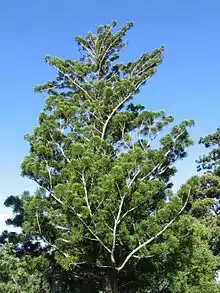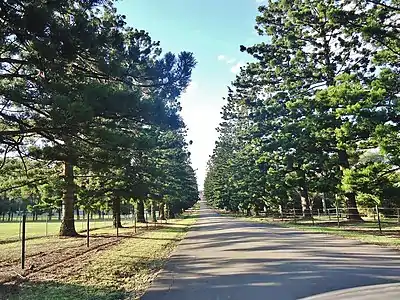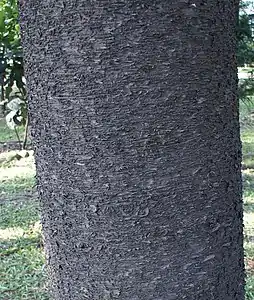Araucaria cunninghamii
Araucaria cunninghamii is a species of Araucaria known as hoop pine. Other less commonly used names include colonial pine, Queensland pine,[3] Dorrigo pine, Moreton Bay pine and Richmond River pine.[1] The scientific name honours the botanist and explorer Allan Cunningham, who collected the first specimens in the 1820s.
| Araucaria cunninghamii | |
|---|---|
 | |
| Scientific classification | |
| Kingdom: | Plantae |
| Clade: | Tracheophytes |
| Division: | Pinophyta |
| Class: | Pinopsida |
| Order: | Pinales |
| Family: | Araucariaceae |
| Genus: | Araucaria |
| Section: | A. sect. Eutacta |
| Species: | A. cunninghamii |
| Binomial name | |
| Araucaria cunninghamii | |
| Synonyms[2] | |
| |
Habitat
The species is found in the dry rainforests of New South Wales and Queensland and in New Guinea. The trees can live up to 450 years and grow to a height of 60 metres.[4] The bark is rough, splits naturally, and peels easily.[5]
Description
The leaves on young trees are awl-shaped, 1–2 cm long, about 2 mm thick at the base, and scale-like, incurved, 1–2 cm long and 4 mm broad on mature trees. The cones are ovoid, 8–10 cm long and 6–8 cm diameter, and take about 18 months to mature. They disintegrate at maturity to release the nut-like edible seeds.
Subspecies
There are two varieties:
- Araucaria cunninghamii var. cunninghamii – Australia, from northeast New South Wales to east-central Queensland, at 0–1,000 m altitude.
- Araucaria cunninghamii var. papuana – New Guinea, on the mountains of Papua New Guinea, and in Irian Jaya, Indonesia, at 100–2,700 m altitude.
Cultivation and other uses
The wood is a high quality timber that is particularly important to the plywood industry and also used for furniture, veneer, joinery, panelling, particle board, flooring and boats.[6] Most natural stands in Australia and Papua New Guinea have been depleted by logging. It is now mainly found on timber plantations; however, the species continues to thrive in protected areas, including Lamington National Park where at least one walking track is named after it.[7] The plantations in Queensland have been subject to damage by a native rat species, Rattus tunneyi, which digs to the roots of a semi-mature tree and kills it, the animal was declared a pest for this reason.[8]
Aboriginal Australians used the resin as cement.[9]
Gallery
 Hoop Pine in Prospect Reservoir in Sydney
Hoop Pine in Prospect Reservoir in Sydney The banded bark of Araucaria cunninghamii
The banded bark of Araucaria cunninghamii
References
- Thomas, P. (2011). "Araucaria cunninghamii". IUCN Red List of Threatened Species. 2011: e.T32835A9734286. doi:10.2305/IUCN.UK.2011-2.RLTS.T32835A9734286.en.
- "Araucaria cunninghamii". World Checklist of Selected Plant Families (WCSP). Royal Botanic Gardens, Kew. Retrieved 23 March 2017.
- "Hoop Pine". Queensland Department of Agriculture and Fisheries. Retrieved 23 March 2017.
- "Hoop Pine". about NSW. Archived from the original on 13 March 2011. Retrieved 25 August 2012.
- "Species: Araucaria cunninghamii (Hoop Pine)". Plantation Information Network. Archived from the original on 18 March 2012. Retrieved 25 August 2012.
- "Hoop Pine". Australian Timber Database. Timber.net.au. Retrieved 25 August 2012.
- "Nature, culture and history". Queensland Government. Archived from the original on 14 August 2012. Retrieved 25 August 2012.
- Baverstock, P.R. (1983). "Pale Field Rat Rattus Tunneyi". In Strahan, R. (ed.). Complete book of Australian mammals. The national photographic index of Australian wildlife (1 ed.). London: Angus & Robertson. p. 451. ISBN 0207144540.
- Corlett, Eloise. "An Evolution Of Ethnobotany". ByronBayNow. Archived from the original on 18 February 2011. Retrieved 25 August 2012.
